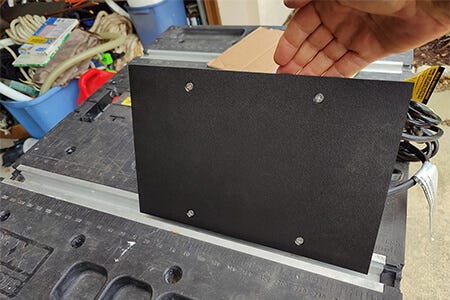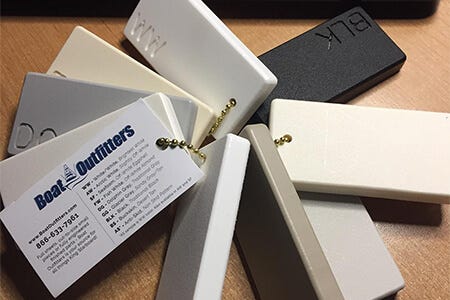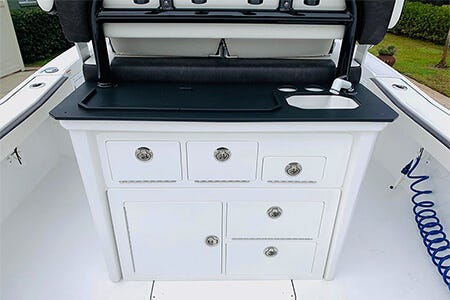

It’s a question that’s asked again and again on boating-related forums and social media groups: What’s the difference between King Starboard and garden-variety high-density polyethylene (HDPE)? For understandable reasons, DIY boaters question why they should spend significantly more on name-brand Starboard than on “generic” HDPE sheets widely available online and at big box home improvement stores. As the world’s biggest buyer and leading fabricator of King Starboard, Boat Outfitters is uniquely positioned to answer that question.
Are King Starboard and HDPE the Same Thing?
Well, yes and no. King Starboard is in fact an HDPE sheet material, but that doesn’t mean it’s the same as other HDPE sheets. Here’s an analogy: All liquors that meet certain criteria (51% to 80% corn mash, aged at least two years in charred oak barrels, etc.) are bourbon, but there’s still plenty of variation between specific bourbons. Likewise, Starboard is one of many different HDPE sheet materials, but it differs from other HDPE sheets in several noteworthy ways.
Superior Quality Control
Much of the HDPE sheet material sold in the United States is manufactured elsewhere — often in China — and imported. Starboard, on the other hand, is manufactured in North Port, Florida, by King Plastics.
This allows King to maintain the highest standards and tightest tolerances. Starboard offers superior consistency in thickness, density, color and flatness. King Starboard is also made entirely from FDA- and USDA-approved material and contains no BPAs or phthalates.
UV Stabilization
Billed as “marine-grade” HDPE sheet, Starboard is UV-stabilized to prevent the polymer’s molecular chains from breaking down as a result of prolonged sun exposure. Garden-variety HDPE sheet is typically not intended for prolonged exposure to sun and other environmental factors and can deteriorate over time.
Garden-variety HDPE sheet is typically not intended for prolonged exposure to sun and other environmental factors and can deteriorate over time.
Compared to wood, all HDPE sheet material is highly resistant to deterioration due to environmental factors, but Starboard is specifically formulated to withstand the marine environment.
Color Stability
The color stability of HDPE — its resistance to fading, yellowing or otherwise discoloring over time — depends primarily on the quality of the pigment used.
King Plastics chooses pigments specifically to withstand long-term sun exposure without discoloration. HDPE sheet not intended for outdoor use often uses lower-quality pigments.
Special Matte Finish
Finishes on HDPE sheet materials vary widely.
Starboard employs a lightly textured matte finish that’s smooth enough to provide a clean, finished look but also does an excellent job of hiding the inevitable scratches and scuffs.
The finish is the same on both sides of the sheet.
Starboard employs a lightly textured matte finish that’s smooth enough to provide a clean, finished look but also does an excellent job of hiding the inevitable scratches and scuffs.
More heavily textured finishes can be harder to keep clean; smoother finishes tend to show imperfections and scratches. Starboard’s finish can also accommodate light sanding as needed to remove stubborn stains or deeper scratches.
Marine-Specific Colors
Another distinguishing characteristic of King Starboard vs. other HDPE sheets is that Starboard is manufactured in a range of whites, off-whites, tans and grays designed to match or compliment the interior colors of the vast majority of today’s recreational boats.
In many cases, a particular Starboard color will be a near-exact match for a given brand’s interior.
For example, Seafoam Starboard matches Boston Whalers built before 2009, while Arctic White matches Whalers built in 2009 or later.
OEM Matching Material
If your boat already has HDPE parts — tackle cabinets, rod racks, access doors or hatches, for example — that you want to match, those parts are almost certainly made from Starboard, which has been the overwhelming choice of boat builders and OEM suppliers like Boat Outfitters for over two decades. In addition to the color, the texture will match as well.
If your boat already has HDPE parts, those parts are almost certainly made from Starboard, which is the overwhelming choice of boat builders.
Characteristics Common to All HDPE Sheets
All that being said, virtually all HDPE sheet materials share most characteristics in common. Any HDPE sheet, for example, is going to offer high impact strength. Other common benefits include imperviousness to moisture, near-zero maintenance and easy fabrication with standard woodworking tools.
When to Use Generic HDPE vs. Starboard
Obviously, Boat Outfitters considers Starboard to be enough better than other HDPE sheet materials for marine applications to justify its higher cost. That being said, there are certain instances when DIYers on a budget can get away with using generic HDPE to save money.
Most often, these projects call for relatively small pieces of HDPE sheet that can be more easily sourced locally. Keep in mind too that you can often purchase a cheap HDPE cutting board for less than the cost of a similarly sized piece of raw material. For projects that require larger pieces of HDPE, Starboard will typically be a better choice.
Applications where the HDPE sheet won’t be readily visible or exposed to sunlight are also good candidates for using generic HDPE.
Applications where the HDPE sheet won’t be readily visible or exposed to sunlight are also good candidates for using generic HDPE. These might include spacers or fillers inside hatches, backing or mounting plates, support blocks, shims, etc. If finish and color are unimportant and the material won’t be regularly exposed to UV, generic HDPE will work just fine.



